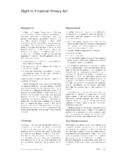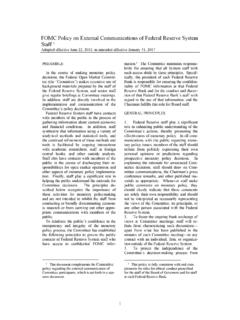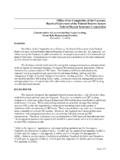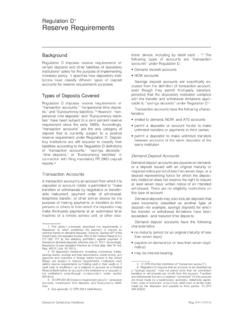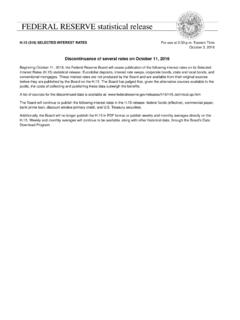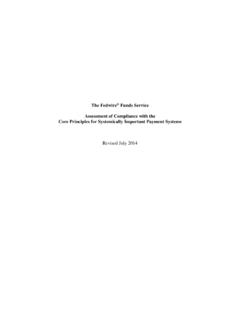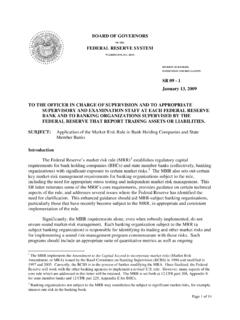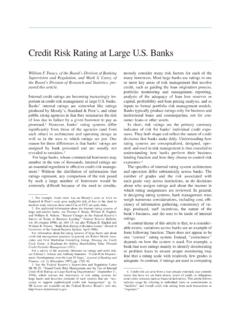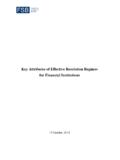Transcription of Federal Reserve Policy on Payment System Risk
1 Federal Reserve Policy on Payment System Risk As amended effective September 15, 2017. 3. risks IN Payment , CLEARING, SETTLEMENT, AND RECORDING SYSTEMS .. 4. PART I. RISK MANAGEMENT FOR financial market infrastructures .. 6. A. Scope ..6. B. Policy expectations for certain financial market infrastructures ..7. 1. Risk management ..7. a. Fedwire Services ..8. b. Designated financial market utilities for which the Board is the Supervisory Agency under Title VIII of the Dodd-Frank Act ..8. c. Other financial market infrastructures that are subject to the Board's supervisory authority under the Federal Reserve Act ..9. d. All other central securities depositories, securities settlement systems, central counterparties, and trade repositories ..9. e. Other systemically important offshore and cross-border Payment systems ..9. 2. Transparency ..9. C. General Policy expectations for other Payment systems within the scope of the 1.
2 Establishment of a risk-management framework ..11. a. Identify risks clearly and set sound risk-management objectives ..11. b. Establish sound governance arrangements to oversee the risk-management framework ..12. c. Establish clear and appropriate rules and procedures to carry out the risk- management objectives ..12. d. Employ the resources necessary to achieve the System 's risk-management objectives and implement effectively its rules and procedures ..12. 2. Other considerations for a risk-management D. Cooperation with other authorities in regulating, supervising, and overseeing financial market infrastructures ..13. PART II. Federal Reserve INTRADAY CREDIT 15. A. Daylight overdraft definition and measurement ..15. B. Collateral ..19. C. Pricing ..19. D. Net debit caps ..20. 1. Definition ..20. 2. Cap categories ..22. a. Self-assessed ..22. b. De minimis ..23. c. Exempt-from-filing ..24. d. Zero ..24. 3. Capital measure.
3 24. a. institutions ..24. b. branches and agencies of foreign banks ..25. E. Maximum daylight overdraft capacity ..25. 1. General procedure ..26. 2. Streamlined procedure for certain FBOs ..27. F. Special situations ..27. 1. Edge and agreement corporations ..28. 2. Bankers' banks ..28. 3. Limited-purpose trust companies ..29. 4. Government-sponsored enterprises and international organizations ..29. 5. Problem institutions ..29. G. Monitoring ..30. 1. Ex post ..30. 2. Real time ..30. 3. Multi-District H. Transfer-size limit on book-entry securities ..31. APPENDIX CPSS-IOSCO PRINCIPLES FOR financial market . 32. 2. INTRODUCTION. financial market infrastructures (FMIs) are critical components of the nation's financial System . FMIs are multilateral systems among participating financial institutions, including the System operator, used for the purposes of clearing, settling, or recording payments , securities, derivatives, or other financial transactions.
4 1, 2 FMIs include Payment systems, central securities depositories, securities settlement systems, central counterparties, and trade repositories. The safety and efficiency of these systems may affect the safety and soundness of financial institutions and, in many cases, are vital to the financial stability of the United States. Given the importance of FMIs, the Board of Governors of the Federal Reserve System (Board) has developed this Policy to set out the Board's views, and related standards, regarding the management of risks that FMIs present to the financial System and to the Federal Reserve Banks ( Reserve Banks). In adopting this Policy , the Board's objective is to foster the safety and efficiency of Payment , clearing, settlement, and recording systems and to promote financial stability, more broadly. Part I of this Policy sets out the Board's views, and related standards, regarding the management of risks in FMIs, including those operated by the Reserve Banks.
5 In setting out its views, the Board seeks to encourage FMIs and their primary regulators to take the standards in this Policy into consideration in the design, operation, monitoring, and assessment of these systems. The Board will be guided by this part, in conjunction with relevant laws, regulations, and other Federal Reserve policies, when exercising its supervisory and regulatory authority over FMIs or their participants, providing accounts and services to FMIs, participating in cooperative oversight and similar arrangements for FMIs with other authorities, or providing intraday credit to eligible Federal Reserve account holders. Designated financial market utilities subject to the Board's Regulation HH are not subject to the risk-management or transparency expectations set out in this Policy . 3. Part II of this Policy governs the provision of intraday credit or daylight overdrafts in accounts at the Reserve Banks and sets out the general methods used by the Reserve Banks to 1.
6 This definition is based on the definition provided in the Committee on Payment and Settlement Systems (CPSS). and Technical Committee of the International Organization of Securities Commissions (IOSCO) report on Principles for financial market infrastructures (PFMI), April 2012, available at (Effective September 2014, the CPSS changed its name to the Committee on payments and market infrastructures .) Further, an FMI generally embodies one or more of the following characteristics: (1) a multilateral arrangement with three or more participants; (2) a set of rules and procedures, common to all participants, that govern the clearing (comparison and/or netting), settlement, or recording of payments , securities, derivatives, or other financial transactions; (3) a common technical infrastructure for conducting the clearing, settlement, or recording process; and (4) a risk-management or capital structure that takes into account the multilateral dependencies inherent in the System .
7 2. The term financial institution, as used in this Policy , refers to a broad array of organizations that engage in financial activity, including depository institutions, securities dealers, and futures commission merchants. 3. The term financial market utility is defined in Title VIII of the Dodd-Frank Wall Street Reform and Consumer Protection Act (Dodd-Frank Act) as any person that manages or operates a multilateral System for the purpose of transferring, clearing, or settling payments , securities, or other financial transactions among financial institutions or between financial institutions and the person. Trade repositories, which the Dodd-Frank Act defines as providing facilities for comparison of data respecting the terms of settlement of securities or futures transactions, are not included in the term financial market utility (12 5462). financial market utilities are, therefore, a subset of the broader set of entities defined as FMIs.
8 Under Title VIII, the financial Stability Oversight Council designates certain financial market utilities as systemically important. The Board's Regulation HH is discussed in section below. 3. control their intraday credit exposures. 4 Under this part, the Board recognizes that the Federal Reserve has an important role in providing intraday balances and credit to foster the smooth operation of the Payment System . The Reserve Banks provide intraday balances by way of supplying temporary, intraday credit to healthy depository institutions, predominantly through collateralized intraday overdrafts. 5 The Board believes that such a strategy enhances intraday liquidity while controlling risk to the Reserve Banks by providing incentives to collateralize daylight overdrafts. The Board also aims to limit the burden of the Policy on healthy depository institutions that use small amounts of intraday credit. Through this Policy , the Board expects financial System participants, including private- sector FMIs and the Reserve Banks, to reduce and control settlement and other systemic risks arising in FMIs, consistent with the smooth operation of the financial System .
9 This Policy is also designed to govern the provision of intraday balances and credit while controlling the Reserve Banks' risk by (1) making financial System participants and FMIs aware of the types of basic risks that may arise in the Payment , clearing, settlement, or recording process; (2) setting explicit risk-management expectations; (3) promoting appropriate transparency by FMIs to help inform participants and the public; and (4) establishing the Policy conditions governing the provision of Federal Reserve intraday credit to eligible account holders. The Board's adoption of this Policy in no way diminishes the primary responsibilities of financial System participants to address the risks that may arise through their operation of or participation in FMIs. risks IN Payment , CLEARING, SETTLEMENT, AND RECORDING SYSTEMS. The basic risks in Payment , clearing, settlement, and recording systems may include credit risk, liquidity risk, operational risk, and legal risk.
10 In the context of this Policy , these risks are defined as follows: 6. Credit risk: the risk that a counterparty, whether a participant or other entity, will be unable to meet fully its financial obligations when due, or at any time in the future. Liquidity risk: the risk that a counterparty, whether a participant or other entity, will be unable to meet fully its financial obligations when due, although it may be able to do so in the future. An FMI, through its design or operation, may bear or generate liquidity risk in one or more currencies in its Payment or settlement process. 7 In this context, liquidity risk may arise between or among the System operator and the participants in the FMI, the 4. To assist depository institutions in implementing part II of this Policy , the Board has prepared two documents, the Overview of the Federal Reserve 's Payment System Risk Policy (Overview) and the Guide to the Federal Reserve 's Payment System Risk Policy (Guide), which are available at The Overview summarizes the Board's Policy on the provision of intraday credit, including net debit caps and daylight overdraft fees, and is intended for use by institutions that incur only small amounts of daylight overdrafts.
